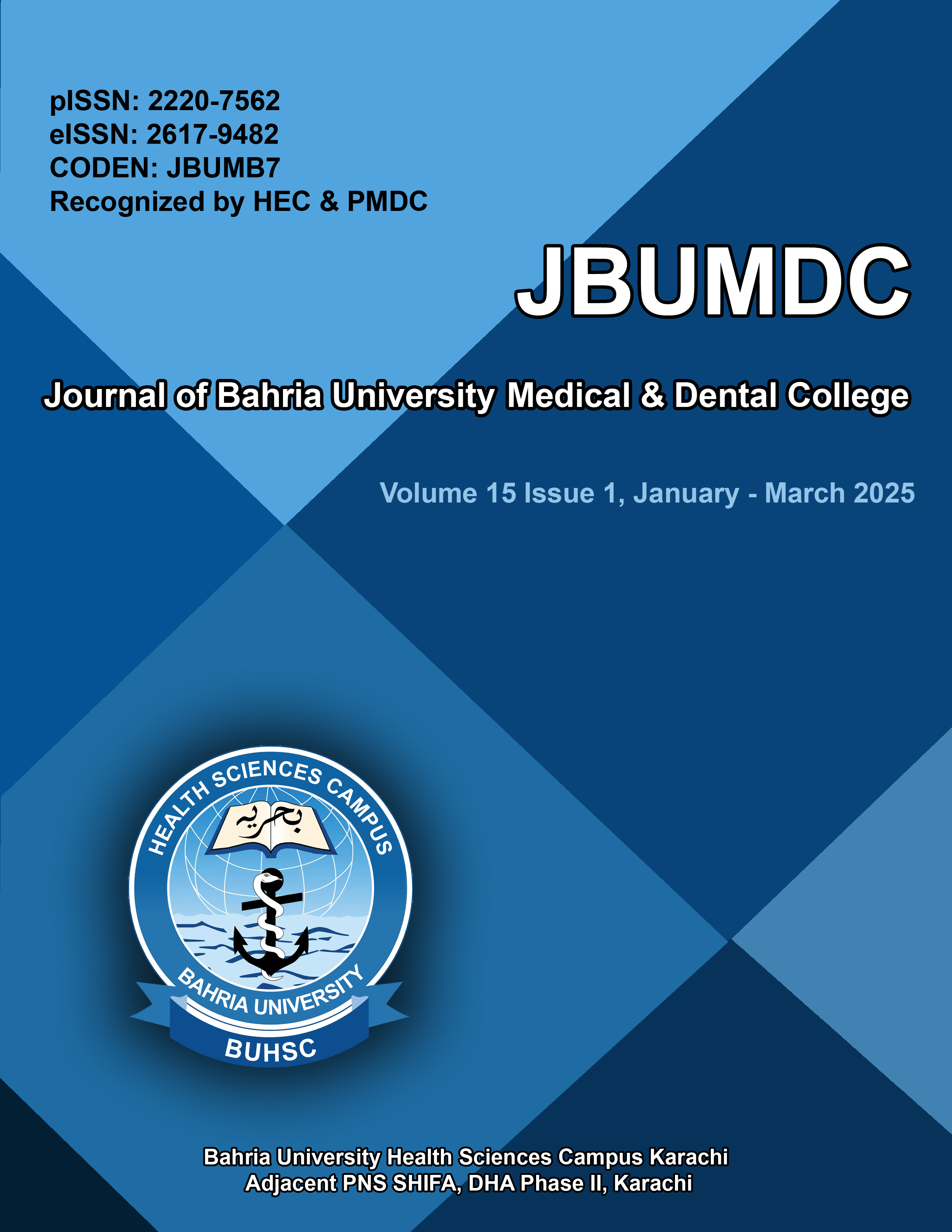Sensitivity and Specificity of the Neutrophil Lymphocyte Ratio (NLR) in Diagnosing Late Onset Neonatal Sepsis in NICU Patients
DOI:
https://doi.org/10.51985/JBUMDC2024408Keywords:
Lymphocyte ratio, neonatal, neutrophil, sepsisAbstract
Objective: To compare the sensitivity and specificity of the neutrophil lymphocyte ratio in diagnosing late onset neonatal sepsis in NICU patients at a tertiary care center
Study Design and Setting: Prospective observational study at Department of Pediatrics, Combined Military Hospital, Lahore from February 2024-July 2024
Methodology: After admission into the NICU for suspected late onset neonatal sepsis, complete blood count, C-reactive protein and blood cultures were sent before changing or starting broad spectrum anti-biotic therapy for 350 patients included in the study. Primary variables observed were sensitivity and specificity of the neutrophil lymphocyte ratio in diagnosing late onset sepsis once co-related with the culture results.
Results: Blood panel parameters showed mean absolute neutrophil count to be 5928.19796.05/mm3versus 7032.80166.02/mm3 between the suspected and confirmed patients’ groups (p<0.001). Similarly, mean absolute lymphocyte count was 2745.32394.53/mm3 versus 3223.60278.90/mm3 between both groups (p<0.001). Median value for NLR was 1.70 (1.00) versus 2.20 (1.00) between the suspected and confirmed culture groups (p<0.001). Assessment of receiver operating characteristics (ROC) for NLR when compared with suspected and confirmed sepsis showed area under the curve being 0.644 (CI=95%) with sensitivity of 74.6%, specificity of 55.6%, positive predictive value being 57.3% and negative predictive value being 73.3% with a cut-off value for NLR being 2.05.
Conclusion: We conclude that neutrophil lymphocyte ratio with a cut-off value of 2.05 is a reliable method to diagnose late onset neonatal sepsis with good sensitivity
References
1. Fleischmann C, Reichert F, Cassini A, Horner R, Harder T,
Markwart R, et al. Global incidence and mortality of neonatal
sepsis: a systematic review and meta-analysis. Archives of
Disease in Childhood. 2021;106(8):745-52. https://doi.org/
10.1136/archdischild-2020-320217
2. Odabasi IO, Bulbul A. Neonatal sepsis. ªiºli Etfal Hastanesi
Tip Bülteni. 2020;54(2):142-58. DOI: 10.14744/ SEMB.2020.
00236
3. Wen SC, Ezure Y, Rolley L, Spurling G, Lau CL, Riaz S, et
al. Gram-negative neonatal sepsis in low-and lower-middleincome countries and WHO empirical antibiotic
recommendations: A systematic review and meta-analysis.
PLoS medicine. 2021;18(9):e1003787.
4. Hayes R, Hartnett J, Semova G, Murray C, Murphy K, Carroll
L, et al. Neonatal sepsis definitions from randomised clinical
trials. Pediatric Research. 2023;93(5):1141-8. https://doi.org/
10.1038/s41390-021-01749-3
5. Rafi MA, Miah MMZ, Wadood MA, Hossain MG. Risk factors
and etiology of neonatal sepsis after hospital delivery: a casecontrol study in a tertiary care hospital of Rajshahi, Bangladesh.
PloS one. 2020;15(11):e0242275. https://doi.org/10.1371
/journal.pone.0242275
6. Köstlin-Gille N, Härtel C, Haug C, Göpel W, Zemlin M,
Müller A, et al. Epidemiology of early and late onset neonatal
sepsis in very low birthweight infants: data from the German
Neonatal Network. The Pediatric infectious disease journal.
2021;40(3):255-9. DOI: 10.1097/INF.0000000000002976
7. Glaser MA, Hughes LM, Jnah A, Newberry D, Harris-Haman
PA. Neonatal sepsis: a review of pathophysiology and current
management strategies. Advances in neonatal care.
2021;21(1):49-60. DOI: 10.1097/ANC.0000000000000769
8. Srinivasan L, Balasubramanian H, Stewart MT, Weiss EM,
Kirpalani H, Cooper C, et al. Procalcitonin for the diagnosis
of sepsis in neonates: a diagnostic test accuracy review. The
Cochrane Database of Systematic Reviews. 2023;2023(4).
https://doi.org/10.1002%2F14651858.CD014196
9. Li T, Dong G, Zhang M, Xu Z, Hu Y, Xie B, et al. Association
of neutrophil–lymphocyte ratio and the presence of neonatal
sepsis. Journal of immunology research. 2020;2020.
https://doi.org/10.1155/2020/7650713
10. Ahmed M, Yasrab M, Khushdil A, Qamar K, Ahmed Z.
Neonatal sepsis in a tertiary care hospital: bacteriological
profile and its antibicrobial sensitivity. Pakistan armed forces
medical journal. 2018;68(6):1654-58.
11. Haque KN. Definitions of bloodstream infection in the
newborn. Pediatric Critical care medicine. 2005;6(3):S45-S9.
DOI: 10.1097/01.PCC.0000161946.73305.0A
12. Mukhopadhyay S, Puopolo KM, Hansen NI, Lorch SA,
DeMauro SB, Greenberg RG, et al. Neurodevelopmental
outcomes following neonatal late-onset sepsis and blood
culture-negative conditions. Archives of Disease in ChildhoodFetal and Neonatal Edition. 2021;106(5):467-73.
https://doi.org/10.1136/archdischild-2020-320664
13. Pan T, Zhu Q, Li P, Hua J, Feng X. Late-onset neonatal sepsis
in Suzhou, China. BMC pediatrics. 2020;20:1-7. https:
//doi.org/10.1186/s12887-020-02103-y
14. Sumitro KR, Utomo MT, Widodo ADW. Neutrophil-tolymphocyte ratio as an alternative marker of neonatal sepsis
in developing countries. Oman Medical Journal.
2021;36(1):e214. https://doi.org/10.5001%2Fomj.2021.05
15. Bai L, Gong P, Jia X, Zhang X, Li X, Zhang Y, et al.
Comparison of neutrophil-to-lymphocyte ratio and plateletto-lymphocyte ratio for the diagnosis of neonatal sepsis: A
systematic review and meta-analysis. BMC pediatrics.
2023;23(1):334. https://doi.org/10.1186/s12887-023-04094-
y
16. Varal IG, Dogan P. Can neutrophil-lymphocyte ratio be a
predictor of late-onset sepsis in preterm infants? 2020.
17. Naseer N, Sheikh TK, Zulfiqar S, Bashir H, Haroon S, Jahangir
J. Neutrophil Lymphocyte Ratio as Screening Tool for Neonatal
Sepsis in Developing Countries. Pakistan Armed Forces
Medical Journal. 2023;73(2):583-86. https://doi.org/10.51253/
pafmj.v73i2.8450
18. AL Nady N, Ismaiel Y, Assar E, Saleh M. Diagnostic Value
of Neutrophil to Lymphocyte Ratio on Neonatal Sepsis in
Full Term and Preterm Neonates. Benha Journal of Applied
Sciences. 2021;6(6):169-77.
19. Zhao G, Chen J, Wang J, Wang S, Xia J, Wei Y, et al. Predictive
values of the postoperative neutrophil-to-lymphocyte ratio,
platelet-to-lymphocyte ratio, and lymphocyte-to-monocyte
ratio for the diagnosis of early periprosthetic joint infections:
a preliminary study. Journal of Orthopaedic Surgery and
Research. 2020;15:1-7. https://doi.org/10.1186/s13018-020-
02107-5
20. Chen C, Yang H, Cai D, Xiang L, Fang W, Wang R.
Preoperative peripheral blood neutrophil-to-lymphocyte ratios
(NLR) and platelet-to-lymphocyte ratio (PLR) related
nomograms predict the survival of patients with limited-stage
small-cell lung cancer. Translational lung cancer research.
2021;10(2):866. https://doi.org/10.21037%2Ftlcr-20-997
Downloads
Published
How to Cite
Issue
Section
License
Copyright (c) 2024 Zunaira Zulfiqar, Unaiza Syed, Syed Arsalan Hassan, Nabeera Hayat, Hamza Khursheed, Abu Bakar Khan

This work is licensed under a Creative Commons Attribution-NonCommercial 4.0 International License.
Journal of Bahria University Medical & Dental College is an open access journal and is licensed under CC BY-NC 4.0. which permits unrestricted non commercial use, distribution and reproduction in any medium, provided the original work is properly cited. To view a copy of this license, visit https://creativecommons.org/licenses/by-nc/4.0 ![]()
Deprecated: json_decode(): Passing null to parameter #1 ($json) of type string is deprecated in /home/u735751794/domains/bahria.edu.pk/public_html/ojs_jbumdc/plugins/generic/citations/CitationsPlugin.inc.php on line 49





